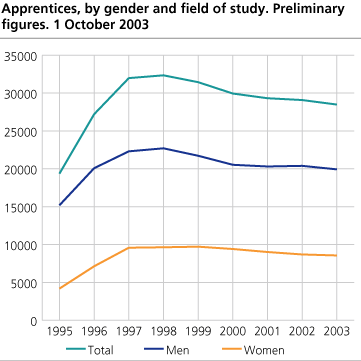Content
Published:
This is an archived release.
Decline in number of apprentices
A total of 28 500 apprentices were registered in upper secondary education by 1 October 2003. This is almost 600 less than corresponding figures last year.
Preliminary figures show that there has been a reduction in the number of apprentices from 2002 to 2003. There has been a stable decline since 1998 where the number of apprentices was approximately 32 400 or 14 per cent higher than in 2003.
The effect of the decline on the various areas of study varies. Number of apprentices in electrical trades and engineering reduced by 400 between 2002 and 2003 while mechanical trades had 280 fewer pupils, a reduction of 7 and 5 per cent respectively. The highest percentage decrease in 2003 was registered in woodworking trades with almost 23 per cent. Total number of apprentices in building and construction trades increased by 330 from 2002 to 2003, an increase of 7 per cent.
The female proportion of apprentices has been consistent at 30 per cent since 1997. Most of the female apprentices are within health and social studies with almost 2 800 apprentices in 2003, approximately 33 per cent of total female apprentices. Arts, crafts and designs as well as hotel and food processing trades were very popular among the female apprentices with 2 400 and 1 450 making up 28 and 17 per cent of all female apprentices.
Fewer new apprentices
Almost half of all apprentices by 1 October 2003 were new apprentices. There were over 13 500 new apprentices compared with 14 300 during the same period in 2002. The female portion of new apprentices in 2003 is a little above 32 per cent. Finnmark had the largest female proportion with over 46 per cent. A look at the ages of new apprentices show that most of them are either 18 or 19 years of age with 6 400 and 2 600 apprentices respectively. Approximately 1 400 new apprentices were 25 years of age or above.
Media and communication has best results
More than 19 000 candidates sat for vocational examinations between 1 October 2002 and 30 September 2003, a decline of 850 or four per cent from the previous year. An estimate of 93 per cent of candidates passed the examinations. There were no significant gender differences in the results but rather among areas of study.
School year 2002/2003 was the first time the candidates from the two new areas of study, media communication and retail and service trades took part in vocational examinations. Candidates from the two new areas of study achieved the best results with 98 and 96 per cent pass- rates respectively. Men performed better than women in media and communication, 99 per cent of men passed compared to 97 per cent of women. The women did better in retail and service trades where the pass-rate for the women was 97 per cent against 92 per cent for men. The highest rate of failure was registered in technical building trades with almost 15 per cent.
Stable number of candidates with vocational training in school
There were almost 11 800 apprentices, 6 800 practice candidates and 600 pupils out of the 19 000 candidates who took part in the vocational examinations between 1 October 2002 and 30 September 2003. While apprentices and practice candidates experienced a decline in total numbers, the numbers of pupils with vocational training in school have remained stable. Approximately 68 per cent of pupils with vocational training in school passed the vocational examinations in school year 2002/2003 and this is five percentage points better than school year 2001/2002. Practise candidates had the lowest rate of failure among the three types of candidates. Almost 95 per cent passed their examinations.
Tables:
- Table 1 Apprentices, by gender and field of study. Preliminary figures. 1 October 2003
- Table 2 Apprentices, by gender and county of residence. Preliminary figures. 1 October 2003
- Table 3 Apprentices, by age and county of residence. Preliminary figures. 1 October 2003
- Table 4 Apprentices, by category and county of residence. Preliminary figures. 1 October 2003
- Table 5 New apprentices, by gender and county of residence. Preliminary figures. 1 October 2002-30 September 2003
- Table 6 New apprentices, by age and county of residence. Preliminary figures. 1 October 2002-30 September 2003
- Table 7 Vocational examination candidates, by results, gender and field of study. Preliminary figures. 1 October 2002-30 September 2003
- Table 8 Candidates who passed a vocational examination, by gender and county of residence. 1 October 2002-30 September 2003
- Table 9 Candidates who passed a vocational examination, by age and county of residence. 1 October 2002-30 September 2003
- Table 10 Vocational examination candidates, by category and results. School year 1998/1999-2002/2003. Perliminary figures 1 October-30 September 2003
The statistics is published with Upper secondary education.
Contact
-
Statistics Norway's Information Centre
E-mail: informasjon@ssb.no
tel.: (+47) 21 09 46 42

